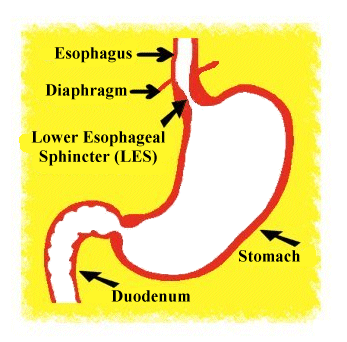What is an EGD?
An EGD (upper endoscopy, gastroscopy, panendoscopy) is an examination
of the esophagus (food pipe), stomach and duodenum (first part of the small
intestine) via insertion of an endoscope (small diameter, flexible tube)
through the mouth and back of the throat into the upper digestive tract.
This allows the physician to examine the lining of the above organs.
Abnormalities suspected by x-ray can be confirmed and others may be detected
which are too small to be seen on x-ray. If the doctor sees a suspicious
area, he can pass an instrument through the endoscope and take a small
piece of tissue (a biopsy) for more thorough examination in the laboratory.
Biopsies are taken for many reasons and do not necessarily imply cancer.
Other instruments can also be passed through the endoscope without causing
discomfort, including a small brush to wipe cells in a suspicious area
for examination in the laboratory (a form of Pap test or "cytology") and
a wire loop or snare to remove polyps (abnormal, usually benign, growths
of tissue).
Do I really need an EGD?
Many problems of the upper digestive tract cannot be diagnosed by x-ray.
EGD may be helpful in the diagnosis of inflammation of the esophagus, stomach
and duodenum (esophagitis, gastritis, duodenitis), and to identify the
site of upper gastrointestinal bleeding. EGD is more accurate than
x-ray in detecting stomach and duodenal ulcers,
especially when there is bleeding or scarring from a previous ulcer.
EGD may detect early cancers too small to be seen by x-ray and confirm
the diagnosis through biopsies and cell brushings. EGD may also be
needed for treatments, for example, to stretch narrowed areas of the esophagus,
control of upper gastrointestinal bleeding, or for the removal of polyps.
What preparation is required?
For the best possible examination, the stomach must be completely empty,
so you should have nothing to eat or drink, including water, from midnight
the evening before your exam. A companion must
accompany you
to the examination because you will be given medication to help you relax.
It will make you drowsy, so you will need someone to drive you home.
You
will not be able to drive after the procedure. Even though you
may not feel tired, your judgment and reflexes may not be normal.
Please bring any x-rays with you, if requested. Plan on arriving
at the hospital one hour before your test is scheduled.
What should I expect during the procedure?
Your doctor will give you medication through a vein to make you relaxed
and sleepy. Please inform the doctor if you have any allergies
to drugs before your test. While you are lying on your left side,
the endoscope is inserted through the mouth and each part of the esophagus,
stomach and duodenum is examined. The procedure is extremely well
tolerated with little or no discomfort. Many patients even fall asleep
during EGD. The scope will not interfere with your breathing.
Gagging is usually prevented by the medication. The procedure usually
lasts five to fifteen minutes.
What happens after the test?
You will be kept in the endoscopy area until most of the effects of
the medication have worn off. Your throat may be a little sore for
a couple of hours and you may feel bloated for a short time because of
the air that was introduced to examine your stomach. You will be
able to resume your normal diet after the EGD unless otherwise instructed.
You will be given appropriate discharge instructions and learning material
before you go home. You should make arrangements in advance to have
someone stay at your home with you for the day.
Are there any complications from EGD?
EGD is safe and is associated with very low risk when performed by
physicians who have been specially trained in endoscopy procedures.
Complications can occur but are rare. One possible complication is
perforation, in which a tear through the wall of the esophagus or stomach
may allow leakage of digestive fluids. This may be managed simply
by aspirating the fluids until the opening seals, or may require surgery.
Bleeding may occur from the site of biopsy or polyp removal. It is
usually minimal but rarely may require transfusions or surgery. Localized
irritation of the vein may occur at the site of medication injection.
A tender lump develops which may remain several weeks to months but goes
away eventually. Other risks include drug reactions and complications
from unrelated diseases such as heart attack or stroke.
When will I know what my test showed?
Dr. Hasan will talk to you or the person accompanying your before you
leave the endoscopy department and preliminary results can usually
be given to you at that time. If a biopsy or cell brushing was taken,
the results will not be received from the laboratory for 3 to 4 days.


|

![]()